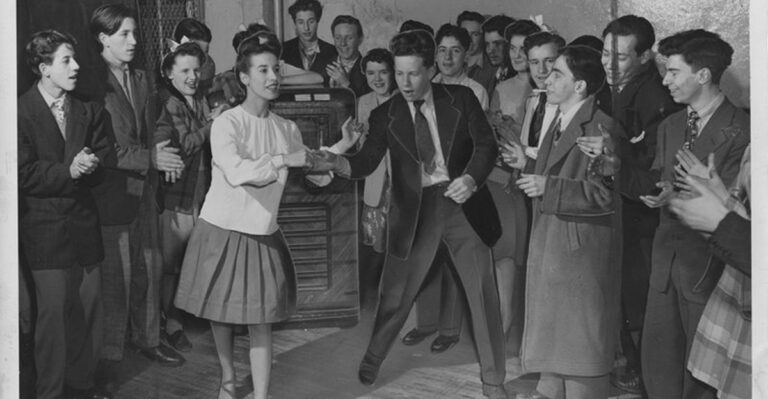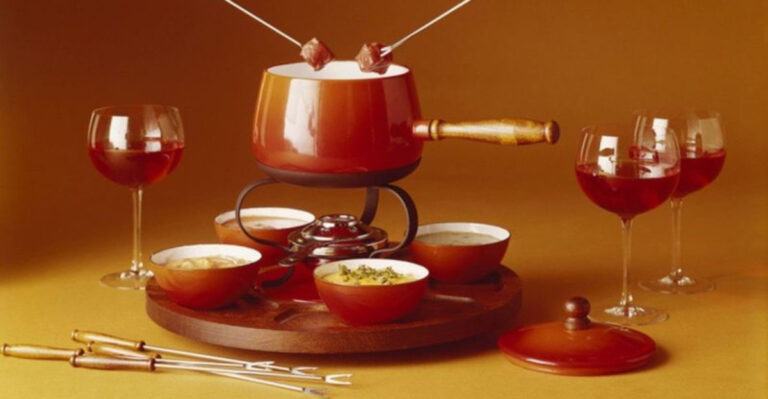31 Fascinating Realities Of Life As A Stay-At-Home Mom In The 1950s
The 1950s housewife: smiling in pearls, baking casseroles, vacuuming in heels… right? Well—sort of.
Behind the tidy homes and perfect lipstick were real women juggling expectations, identity, and a ton of laundry. Life as a stay-at-home mom in the ’50s wasn’t just about Jell-O molds and PTA meetings—it was a complex mix of joy, exhaustion, quiet rebellion, and carefully hidden dreams.
In this post, we’re lifting the curtain on 31 fascinating truths about being a stay-at-home mom in the 1950s—some charming, some surprising, and some that might make you say, “Wait, they really did that?”
Grab your vintage coffee cup. Let’s time-travel.
1. The Breakfast Routine

Starting the day in the 1950s meant waking up early to prepare breakfast for the whole family. The stay-at-home mom, often the first to rise, orchestrated the morning meal. The breakfast table was a place to gather, share news, and plan the day.
The clatter of dishes and the hum of conversation created a warm, inviting atmosphere. Cereal was a staple, but nothing beat a homemade spread. This daily ritual wasn’t just about nourishment; it was about family bonding.
Mornings set the tone for the rest of the day, and every mom knew the importance of a good, hearty breakfast.
2. The Fashion Statement
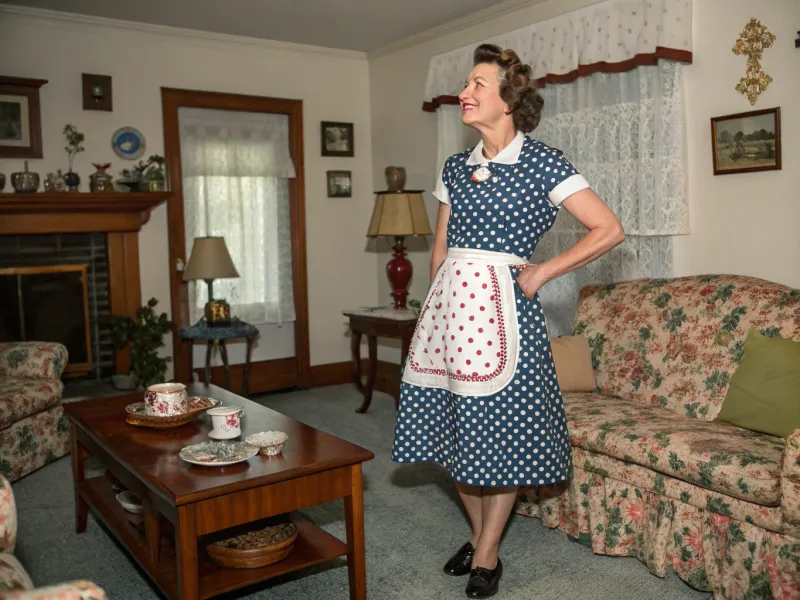
In the 1950s, fashion was more than just clothing; it was a statement of identity and pride. Dressing up was a daily ritual, even if it was just to do the laundry or vacuum the living room.
Clothes were meticulously ironed, and every detail mattered, from hairdos to matching accessories. This attention to appearance extended beyond personal style; it reflected the home’s atmosphere.
The effort put into looking presentable was about self-respect and setting a positive example for the family. It was a time when being well-dressed was synonymous with being well-prepared for whatever the day might bring.
3. The Laundry Day Marathon
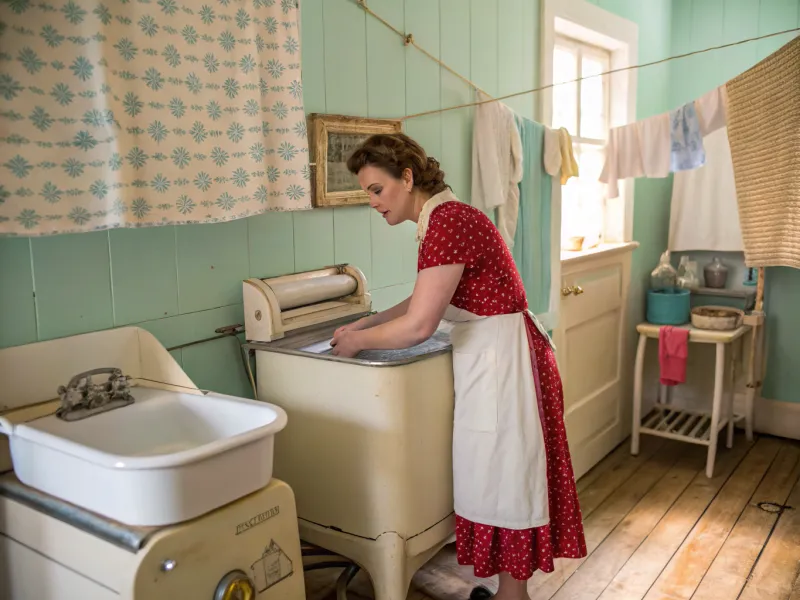
Laundry day in the 1950s was a marathon event, requiring planning and endurance. Stay-at-home moms spent hours sorting clothes, scrubbing stubborn stains, and hanging garments on the line to dry.
The process was labor-intensive but also a time for reflection, perhaps on the week’s events or future plans. It was a moment of solitude amid a busy household.
Despite the hard work, there was satisfaction in seeing clean clothes neatly folded, ready to be worn again. This task was a testament to a mother’s dedication—a symbol of care and nurturing, woven into the fabric of daily life.
4. The Art of Homemaking
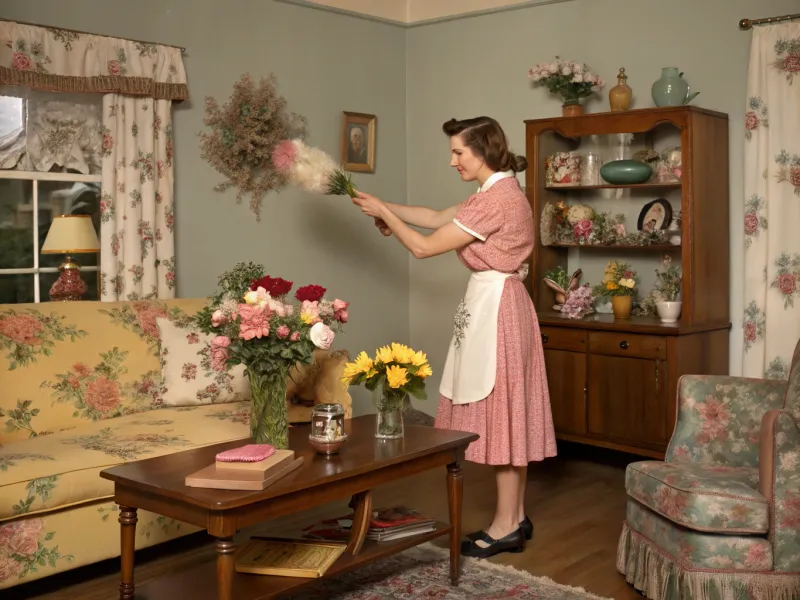
Homemaking was considered an art form in the 1950s, with stay-at-home moms as its dedicated artists. Moms took pride in creating a welcoming environment, often involving routine dusting, vacuuming, and even flower arranging.
It was more than just keeping a clean house; it was about creating a sanctuary for the family. Every corner of the home reflected the care and effort put into maintaining it.
The homemaker’s touch was evident in every detail, from the plumpness of the cushions to the shine of the windows. It was a labor of love, an expression of devotion to the family’s well-being.
5. The Grocery Shopping Expedition

Grocery shopping in the 1950s was an expedition, complete with a detailed list and a budget to consider. Stay-at-home moms were navigating aisles filled with canned goods and fresh produce, carefully selecting items for the week’s meals.
Shopping was a strategic endeavor, balancing quality and cost while ensuring the pantry stayed stocked. Coupons were clipped, and sales were a focal point of the shopping trip.
This task was not just about acquiring food; it was a chance to connect with the community. The local grocer knew many customers by name, and these interactions were part of the social fabric of the neighborhood. Each trip was an opportunity to exchange recipes, tips, and stories.
6. The PTA Meeting

PTA meetings were a cornerstone of community involvement for stay-at-home moms in the 1950s. These gatherings were instrumental in shaping school policies and enhancing the educational experience for children.
Moms collaborated on fundraisers and volunteered for school activities, reflecting their commitment to their children’s education.
Beyond academics, PTA meetings were a social outlet, providing moms with a sense of purpose and camaraderie. They were forums for exchanging ideas, voicing concerns, and celebrating achievements. Participation in these meetings underscored the importance of community in raising well-rounded children.
7. The Tupperware Party Phenomenon

Tupperware parties were a social phenomenon in the 1950s, offering a blend of commerce and camaraderie. These parties were more than just sales pitches; they were events.
Hosts demonstrated the versatility of Tupperware, showcasing its airtight seals and vibrant colors, while guests enjoyed refreshments and conversation.
Attending these parties was an opportunity to socialize, share household tips, and maybe even earn a little extra income as a part-time Tupperware consultant. They were a testament to innovation, both in product design and in the way women engaged with each other socially and economically.
8. The Afternoon Tea Tradition

Afternoon tea was a cherished tradition for many stay-at-home moms in the 1950s, offering a moment of respite in the day. This was a time for relaxation and reflection.
Moms would invite friends or neighbors over, sharing stories, laughter, and sometimes, gentle advice. The clinking of teacups and the murmur of conversation created an atmosphere of warmth and connection.
Tea time was more than a break; it was a ritual that reinforced friendships and community bonds. It was a small but significant pleasure amidst the daily routine, reminding moms of the importance of taking time for themselves.
9. The Home-Cooked Meal

In the 1950s, the home-cooked meal was central to family life, symbolizing love and nourishment. Cooking was both an art and a science, requiring skill and creativity.
Meals were occasions for the family to gather, share their day, and enjoy each other’s company. The preparation of these meals was a labor of love, involving planning, shopping, and hours in the kitchen.
The satisfaction of seeing family enjoy a well-cooked meal was reward enough for the effort involved. It was a way for moms to express care and ensure the family’s health and happiness.
10. The Family Road Trip
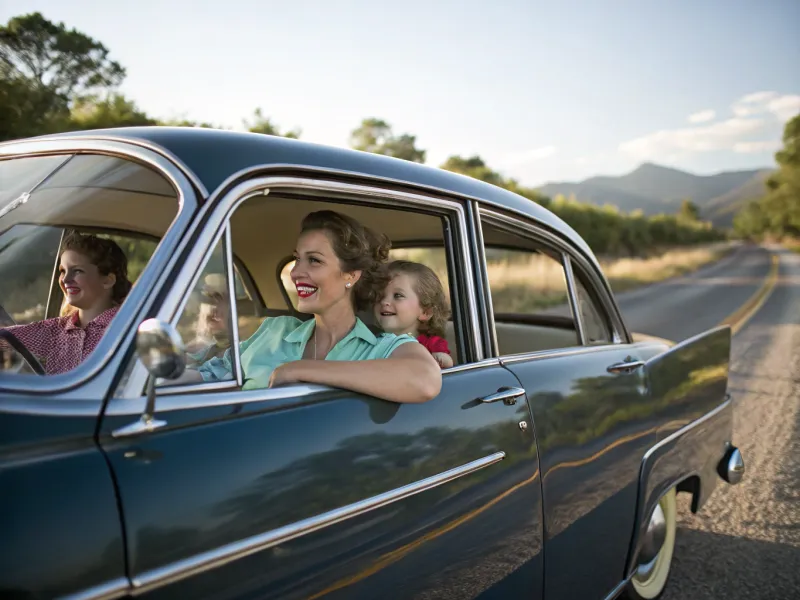
Family road trips in the 1950s were adventures filled with excitement and discovery. Maps were unfolded, routes planned, and landmarks eagerly anticipated.
These trips were about creating memories, from scenic drives to roadside picnics. The open road offered a sense of freedom and adventure, a break from the daily routine.
For moms, it was an opportunity to bond with the family, share stories, and maybe even sing along to favorite tunes. Road trips encapsulated the joy of exploration and the simple pleasure of time spent together.
11. The Holiday Preparation Excitement

The excitement of holiday preparations was palpable in the 1950s, with stay-at-home moms leading the charge. Moms orchestrated these celebrations with creativity and joy.
Every detail was carefully considered, from the twinkling lights on the tree to the festive table settings. Holidays were about tradition, family, and creating lasting memories.
For moms, the satisfaction came from seeing their efforts bring joy to their families. These celebrations were a testament to love and dedication, creating a warm and inviting atmosphere that embraced the holiday spirit.
12. The Sewing Circle

Sewing circles were a staple in the life of a 1950s stay-at-home mom, blending creativity with community. These circles were about more than just sewing; they were about connection.
As hands worked diligently, conversations flowed, offering advice, support, and the latest neighborhood news. Moms created garments and gifts, turning simple materials into cherished items.
Sewing circles were a creative outlet and a source of companionship. They fostered a sense of accomplishment and were a testament to the skills and resourcefulness of these dedicated homemakers.
13. The Backyard Barbecue

Backyard barbecues were a beloved tradition in the 1950s, bringing families and neighbors together. Moms played a central role in these gatherings, from preparing side dishes to organizing games for the kids.
These events were about more than just food; they were an opportunity to relax, socialize, and enjoy the outdoors. Laughter and music often filled the air, creating a festive atmosphere.
For moms, barbecues were a chance to showcase their culinary skills and hospitality. They fostered a sense of community and were a highlight of summertime living.
14. The School Bake Sale

School bake sales were a staple of community life in the 1950s, with stay-at-home moms at the helm. Picture a bustling school gym filled with tables of homemade treats, from cookies to pies, all lovingly baked by the moms.
Bake sales were about more than fundraising; they were community events. Moms exchanged recipes, tips, and stories, strengthening bonds with other families.
For moms, participation was a point of pride and an opportunity to contribute to the local school. The aroma of fresh-baked goods and the joy of seeing children enjoy the treats made the effort worthwhile. It was a sweet way to support education and community spirit.
15. The Housework Routine

The housework routine in the 1950s was a daily balancing act, with stay-at-home moms as the conductors. Cleaning, dusting, and organizing were part of the daily routine, ensuring a tidy and welcoming environment.
Housework was a never-ending cycle, demanding time, energy, and attention to detail. Yet, these tasks were performed with love and a sense of duty.
For moms, maintaining a clean home was a reflection of care and pride. It was about creating a comfortable space for the family, a sanctuary from the outside world. Each chore completed was a small victory in the pursuit of domestic harmony.
16. The Family Game Night

Family game nights were a cherished tradition in the 1950s, offering fun and bonding opportunities. Moms spearheaded these evenings, selecting games and snacks to ensure everyone had a great time.
Games like Monopoly and Scrabble were favorites, challenging both young and old alike. These nights were about more than winning; they were about spending quality time together.
For moms, game nights were a way to connect with family, fostering communication and teamwork. It was a simple yet meaningful tradition that strengthened family bonds and created happy memories.
17. The Neighborhood Gossip

Neighborhood gossip was the social glue that connected stay-at-home moms in the 1950s. This informal network was a lifeline for sharing advice, support, and companionship.
Conversations ranged from family matters to community events, with each mom adding her perspective. It was a time for laughter, empathy, and sometimes, a little venting.
Gossip was more than idle chatter; it was about building relationships and staying informed. For moms, these moments were a break from daily routines, offering a sense of belonging and community. It was the original social network.
18. The Craft of Canning

Canning was both a craft and a necessity for 1950s stay-at-home moms, preserving the bounty of the garden for future use.
Moms took pride in their canning skills, often using family recipes passed down through generations. It was a labor-intensive process but rewarding, ensuring a supply of homegrown goodness year-round.
Canning was about resourcefulness and tradition. For moms, it was a way to provide for the family with love and care, transforming harvests into lasting sustenance. The sight of neatly stacked jars was a testament to their dedication and skill.
19. The Family Picnic

Family picnics in the 1950s were delightful affairs, blending nature and togetherness. Moms packed these meals with care, considering every detail.
Picnics were about escaping the confines of daily life, relaxing in the open air, and enjoying simple pleasures. Children played nearby, while parents chatted and basked in the moment.
For moms, organizing a picnic was a chance to showcase their culinary skills and create an atmosphere of leisure. These outings were about making memories and fostering family bonds, a joyful break in the routine.
20. The Home Economics Lesson

Home economics lessons were a cornerstone of 1950s education, preparing young women for future roles as homemakers.
These lessons were about imparting practical skills and values, ensuring students were well-equipped for domestic life. Moms volunteered as guest speakers, offering firsthand knowledge and tips.
Home economics was about more than skills; it was about instilling confidence and independence. For moms, teaching these lessons was an opportunity to contribute to the community and inspire the next generation of homemakers.
21. The Family Scrapbook

Creating a family scrapbook was a beloved pastime for 1950s moms, capturing memories in a tangible form.
Scrapbooking was a creative endeavor, allowing moms to craft stories through images and captions. It was a way to preserve family history and celebrate milestones.
For moms, the process was therapeutic and rewarding, offering a chance to reflect on cherished moments. Scrapbooks were treasures that connected generations, each page a testament to love and legacy.
22. The Evening Radio Hour

The evening radio hour was a cherished ritual in the 1950s, bringing families together for entertainment and news.
Moms looked forward to this time, a chance to unwind and connect with loved ones. Favorite shows and music filled the air, offering a welcome break from daily tasks.
The radio hour was about relaxation and bonding, a shared experience that nurtured family ties. It was a simple pleasure that brought joy and comfort, a reminder of the power of storytelling and music.
23. The Volunteer Spirit

Volunteering was a vital aspect of life for 1950s stay-at-home moms, reflecting a commitment to community and service.
Volunteering was about giving back, using skills and time to make a difference. It was a chance to connect with others and work towards common goals.
For moms, volunteering was fulfilling and empowering, offering a sense of purpose beyond the home. It was about being part of something bigger, contributing to the well-being of the community. Each act of kindness strengthened bonds and enriched lives.
24. The Dance of Household Chores

Household chores in the 1950s were a choreographed dance, with stay-at-home moms as the skilled performers.
These tasks required multitasking and efficiency, turning routine into rhythm. Moms moved through the house with grace and purpose, ensuring everything ran smoothly.
Chores were more than work; they were an expression of care and dedication. The home was their stage, and each completed task was a step in the dance of daily life. It was about creating harmony and comfort, a labor of love.
See also: 30 Myths About 1950s Housewives And Why Women Won’t Go Back
25. The Holiday Card Tradition

The tradition of sending holiday cards was a cherished ritual in the 1950s, connecting families and friends. Picture a living room where mom sits, pen in hand, surrounded by cards and envelopes, each message carefully crafted.
Holiday cards were about spreading joy and love, a way to reach out and share the spirit of the season. Moms took pride in selecting beautiful designs and writing heartfelt notes.
For moms, this tradition was about connection and creativity, a chance to express gratitude and affection. Each card was a token of friendship, a reminder of the bonds that held people together, no matter the distance.
26. The Soda Fountain Outing

Soda fountain outings were a treat for 1950s families, offering a taste of sweetness and nostalgia. Imagine a brightly lit soda shop where a mom and her children share a milkshake, laughter echoing over the counter.
These outings were about more than indulgence; they were a celebration of togetherness. The clink of glasses and the swirl of straws created a joyful atmosphere.
Soda fountains were a chance to enjoy simple pleasures and make memories with their children. It was a reminder of life’s little joys, a sweet escape from the everyday routine, and a symbol of community spirit.
27. The Letter Writing Habit

Letter writing was an essential means of communication for 1950s stay-at-home moms, connecting them with loved ones near and far. Picture a desk where mom sits, pen poised over paper, crafting messages with care.
Letters were about more than words; they were an expression of thought and emotion, a lifeline to family and friends. Moms poured their hearts into these missives, sharing stories and sentiments.
For moms, letter writing was a cherished ritual, offering a moment of reflection and connection. Each letter was a tangible piece of their world, sent with love and anticipation, bridging distances and strengthening ties.
28. The Movie Matinee Escape

Movie matinees offered a delightful escape for 1950s stay-at-home moms, a chance to immerse in stories and star-studded dreams. Picture a dimly lit theater where mom sits, popcorn in hand, lost in the flickering scenes.
These outings were a respite from daily routines, providing entertainment and inspiration. Films transported moms to different worlds, offering a break from the ordinary.
Matinees were a cherished treat, a time to unwind and enjoy the magic of cinema. It was an experience that sparked conversation and imagination, a moment of personal indulgence amidst the responsibilities of home life.
29. The Gardening Passion

Gardening was a passion for many 1950s stay-at-home moms, a blend of labor and love. Imagine a garden where mom tends to vibrant blooms and rows of vegetables, her hands nurturing life from the soil.
Gardening was about more than aesthetics; it was a connection to nature, a source of sustenance and satisfaction. Each plant was a testament to patience and care.
Gardening was a therapeutic escape, a creative outlet that yielded beauty and bounty. It was about nurturing growth, both in the garden and in their own spirit, a reminder of life’s cycles and rewards.
30. The Secret Language of Coupons
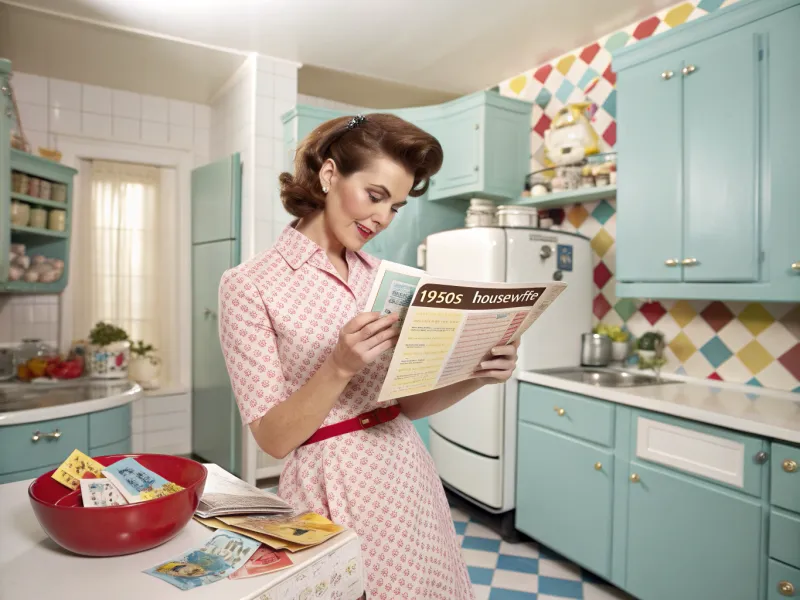
Did you know the 1950s had its own secret language? Coupons were more than just discounts; they represented a savvy housewife’s badge of honor. With scissors in hand, moms clipped away, exchanging tips at grocery stores.
The thrill of getting the best deal was akin to a strategic game, requiring planning and precision. Sundays were dedicated to poring over newspaper inserts, a ritual that turned into a family affair.
In an era without digital aids, these colorful slips of paper connected communities. A shared glance over a bargain meant camaraderie, sparking friendships over savings.
31. The Radio Soap Opera Addiction
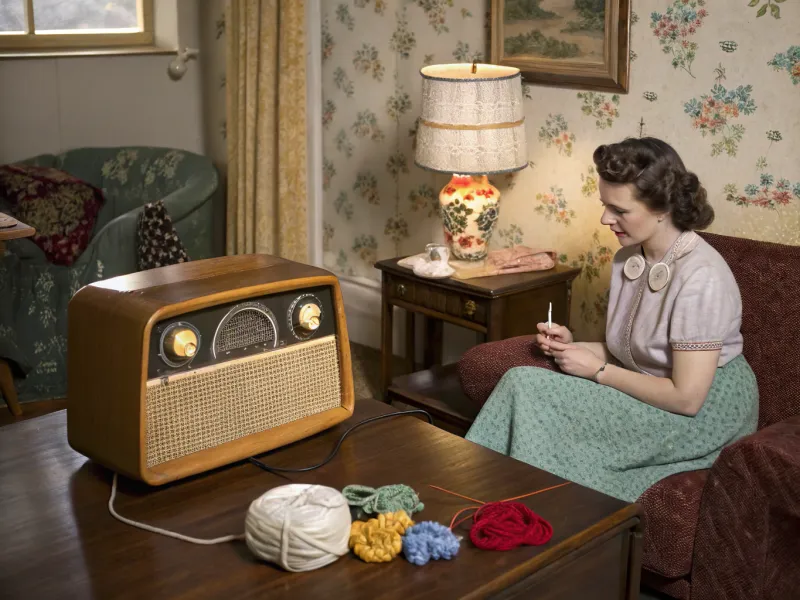
Every afternoon, living rooms across America buzzed with excitement as soap operas filled the airwaves. For many stay-at-home moms, these radio dramas offered a much-needed escape from daily routines.
Characters became friends, their stories entwined with those of the listeners. Moms planned chores around broadcast times, ensuring they never missed an episode.
The power of storytelling through radio was profound, creating a shared national experience. Debates over plot twists were common at local gatherings. These audio adventures provided emotional support and entertainment all in one, enriching lives with every episode.

